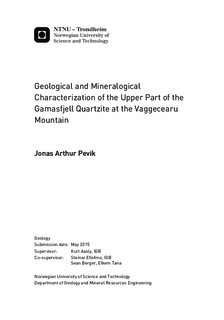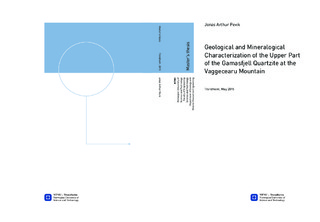| dc.description.abstract | In Northern Norway on the Varanger Peninsula, the Gamasfjell quartzite extends as a belt over a large area, from Porsganger in the west to Skallelv in the east. The Gamasfjell Formation is Precambrian in age, and represents an important industrial mineral resource, where the upper part is mined by Elkem Tana for ferrosilicon and silicon, in Autertana, Finnmark. For Elkem Tana, the quality of the quartzite is defined primarily by its chemical purity (SiO2 concentration), where Al2O3, Fe2O3 and TiO2 represent the main contaminating oxides.
The upper part of the Gamasfjell Formation on the Vaggecearru Mountain, approximately 2 km NE of the mine, has been mapped and sampled for mineralogical examination. Samples were studied in microscope and analyzed by ICP-EOS, XRD and EMP. The data have been used to produce a 3D model of the deposit.
The upper part of the Gamasfjell formation was divided into three distinct sub units, based on visual appearance. In descending order, these units have been termed Unit A, Unit B and Unit C. Unit A (~38m thick) is light gray, massive and extensively cemented. Unit B (~18m thick) alternates between pink and red and contains more hematite. Unit C alternates between several shades and tints of red, small-scale sedimentary structures are characteristic. Hematite and the phylliosilicates, sericite and pyrophyllite are relatively abundant. Each of the visually defined units could also be recognized chemically. In Unit A there is a minimal amount of contaminating oxides and it therefore represents good quality quartzite, Unit B has a high Fe2O3 content and represents intermediate quality. Unit C contains high amounts of all three contaminating oxides and represents the footwall of the deposit.
Structurally, the Gamasfjell Formation is folded by a gentle, upright, horizontal fold. Three main joint sets affect the strata, as well as a set of pervasive master joints. Weathering has caused alteration in zones surrounding the joints, particularly in Unit B.
Both the mineralogical and textural maturity of the quartzite decreases with stratigraphic depth. Clay minerals are autogenic in origin, and were likely produced by dissolution, alteration and replacement of detrital feldspar, during diagenesis. The uppermost part of the formation is interpreted to have been reworked or recycled to a larger degree, destroying feldspar before burial. Hematite was probably formed shortly after deposition (apparent by grain coatings) and during burial diagenesis, by the dissolution of iron bearing minerals. Rutile may be both detrital and diagenetic in origin (as the polymorph antase). A strong correlation between TiO2 and Al2O3 may point towards the latter.
Based on the 3D model, a resource estimation of the SE flank was made, showing promising results, with large amounts of good quality quartzite. | |

